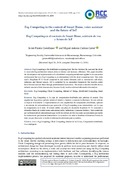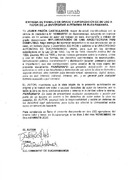Mostrar el registro sencillo del ítem
Implementación de una arquitectura Fog Computing
| dc.contributor.advisor | Cadena Carter, Miguel | spa |
| dc.contributor.author | Pinzón Castellanos, Javier | spa |
| dc.coverage.spatial | Colombia | spa |
| dc.date.accessioned | 2020-12-11T16:53:59Z | |
| dc.date.available | 2020-12-11T16:53:59Z | |
| dc.date.issued | 2020 | |
| dc.identifier.uri | http://hdl.handle.net/20.500.12749/11908 | |
| dc.description.abstract | Fog Computing ó La computación de niebla ha despertado gran interés en la academia, debido a la separación de procesos que se realizan en Cloud Computing (la computación en la nube) permitiendo esto el ahorro de costos en las tecnologías de la información y las comunicaciones. Sin embargo, la tendencia del Cloud Computing ha ido creciendo en el procesamiento y el almacenamiento por consiguiente los precios también. Por ello se diseña una arquitectura en el cual logra realizar un procesamiento local que ayude a disminuir el consumo de la nube. Con base en lo anterior, se realizó́ una investigación utilizando la arquitectura de Fog Computing que consiste en realizar la implementación de este con hardware y software libre, identificando los diferentes módulos que se utilizan para comunicarse e integrar módulos de software. Es por esto, que se realiza un estado del arte de la arquitectura y un proceso de implementación con metas académicas esto con el fin de entender el comportamiento, su operación y la separación entre las nuevas tendencias de arquitectura como Internet of Things (internet de las cosas) y Dew Computing (computación de lagrima), dentro de una documentación de la nueva arquitectura tecnológica. | spa |
| dc.description.tableofcontents | INTRODUCCIÓN 1. PROBLEMA DE INVESTIGACIÓN, PROPÓSITO Y ENFOQUES 14 2. OBJETIVOS DEL PROYECTO 16 2.1 OBJETIVO GENERAL 16 2.2 OBJETIVOS ESPECÍFICOS 16 3. MARCO REFERENCIAL 17 3.1 MARCO CONCEPTUAL 17 3.1.1 CLOUD COMPUTING. 17 3.1.2 FOG COMPUTING. 18 3.1.3 DEW COMPUTING. 18 3.1.4 INTERNET OF THINGS. 19 3.2 MARCO TEORICO 19 3.3 MARCO CONTEXTUAL 21 3.4 MARCO LEGAL 22 3.5 ESTADO DEL ARTE 22 3.5.1 REVISIÓN SISTEMÁTICA DE LA LITERATURA. 23 3.5.2 ANÁLISIS ESTADO DEL ARTE. 28 4. PROCESO INVESTIGATIVO 31 4.1 DESCRIPCIÓN DEL PROCESO INVESTIGATIVO 31 7 4.2 PLANTEAMIENTO DE LA PLATAFORMA 32 4.2.1 ESPECIFICACIÓN DEL ACTOR. 32 4.2.2 DESCRIPCIÓN DE CASOS DE USO. 32 4.2.3 DIAGRAMA DE CASOS DE USO. 33 4.2.4 ARQUITECTURA GENERAL DE LA PLATAFORMA PROPUESTA. 34 4.2.5 DINÁMICA DE PETICIONES. 34 5. RESULTADOS 38 5.1 ESTADO DEL ARTE REFERENTE A FOG COMPUTING 38 5.2 HERRAMIENTAS DE HARDWARE Y SOFTWARE LIBRE 48 5.2.1 HARDWARE. 48 5.2.2 SOFTWARE. 52 5.3 CONFIGURACIÓN DE LOS COMPONENTES 55 5.3.1 CONFIGURACIÓN DEL HARDWARE Y SOFTWARE. 55 5.4 MEDICIONES PERTINENTES. 72 5.4.1 FUNCIONAMIENTO DE LA ARQUITECTURA FOG COMPUTING. 72 5.4.2 ESCENARIOS PROPUESTOS. 73 5.5 APLICACIONES DE FOG COMPUTING 80 5.5.1 FOG COMPUTING EN DOMÓTICA. 80 5.5.2 FOG COMPUTING EN LA INDUSTRIA. 82 5.5.3 FOG COMPUTING EN LAS CIUDADES INTELIGENTES. 83 5.5.4 FOG COMPUTING EN MEDICINA. 85 6. CONCLUSIONES Y RECOMENDACIONES 86 7. REFERENCIAS 88 | spa |
| dc.format.mimetype | application/pdf | spa |
| dc.language.iso | spa | spa |
| dc.rights.uri | http://creativecommons.org/licenses/by-nc-nd/2.5/co/ | * |
| dc.title | Implementación de una arquitectura Fog Computing | spa |
| dc.title.translated | Implementation of a Fog Computing architecture | spa |
| dc.degree.name | Magíster en Gestión, Aplicación y Desarrollo de Software | spa |
| dc.publisher.grantor | Universidad Autónoma de Bucaramanga UNAB | spa |
| dc.rights.local | Abierto (Texto Completo) | spa |
| dc.publisher.faculty | Facultad Ingeniería | spa |
| dc.publisher.program | Maestría en Gestión, Aplicación y Desarrollo de Software | spa |
| dc.description.degreelevel | Maestría | spa |
| dc.type.driver | info:eu-repo/semantics/masterThesis | |
| dc.type.local | Tesis | spa |
| dc.type.coar | http://purl.org/coar/resource_type/c_bdcc | |
| dc.subject.keywords | Systems engineer | eng |
| dc.subject.keywords | Software development | eng |
| dc.subject.keywords | IoT | eng |
| dc.subject.keywords | System analysis | eng |
| dc.subject.keywords | Computer software industry | eng |
| dc.subject.keywords | Internet software industry | eng |
| dc.identifier.instname | instname:Universidad Autónoma de Bucaramanga - UNAB | spa |
| dc.identifier.reponame | reponame:Repositorio Institucional UNAB | spa |
| dc.type.hasversion | info:eu-repo/semantics/acceptedVersion | |
| dc.rights.accessrights | info:eu-repo/semantics/openAccess | spa |
| dc.rights.accessrights | http://purl.org/coar/access_right/c_abf2 | spa |
| dc.relation.references | Aazam, M., & Huh, E.-N. (2016). Fog Computing: The Cloud-IoT\/IoE Middleware Paradigm. IEEE Potentials, 35(3), 40–44. https://doi.org/10.1109/MPOT.2015.2456213 | spa |
| dc.relation.references | Ashwini, T., & SG, M. A. (2015). Fog Computing to protect real and sensitivity information in Cloud. Recuperado a partir de http://citeseerx.ist.psu.edu/viewdoc/download?doi=10.1.1.675.846&rep=rep1&type=pdf | spa |
| dc.relation.references | Bonomi, F., Milito, R., Zhu, J., & Addepalli, S. (2012). Fog computing and its role in the internet of things. En Proceedings of the first edition of the MCC workshop on Mobile cloud computing (pp. 13–16). ACM. | spa |
| dc.relation.references | Celebre, A. M. D., Dubouzet, A. Z. D., Medina, I. B. A., Surposa, A. N. M., & Gustilo, R. C. (2015). Home automation using raspberry Pi through Siri enabled mobile devices. En 2015 International Conference on Humanoid, Nanotechnology, Information Technology,Communication and Control, Environment and Management (HNICEM) (pp. 1–6). https://doi.org/10.1109/HNICEM.2015.7393270 | spa |
| dc.relation.references | Chang, K.-D., Chen, J.-L., Chen, C.-Y., & Chao, H.-C. (2012). IoT operations management and traffic analysis for Future Internet. En Computing, Communications and Applications Conference (ComComAp), 2012 (pp. 138–142). IEEE | spa |
| dc.relation.references | Dastjerdi, A. V., Gupta, H., Calheiros, R. N., Ghosh, S. K., & Buyya, R. (2016). Fog Computing: Principals, Architectures, and Applications. arXiv preprint arXiv:1601.02752 | spa |
| dc.relation.references | Dr. Deepti Sharma, P. K. (2015). A Detail Review on Cloud, Fog and Dew Computing. International Journal of Science, Engineering and Technology Research (IJSETR), 5(5), 9. | spa |
| dc.relation.references | Gia, T. N., Jiang, M., Rahmani, A.-M., Westerlund, T., Liljeberg, P., & Tenhunen, H. (2015). Fog Computing in Healthcare Internet of Things: A Case Study on ECG Feature Extraction (pp. 356–363). IEEE. https://doi.org/10.1109/CIT/IUCC/DASC/PICOM.2015.51 | spa |
| dc.relation.references | Hakyong KIM. (2014, julio 11). Comparison among Cloud Computing, Fog Computing, and Dew Computing. Recuperado a partir de http://hakyongkim.net/Sharing/style/computing.png | spa |
| dc.relation.references | Homekit Siri - Domoticz. (2016). Recuperado el 2 de enero de 2017, a partir de https://www.domoticz.com/wiki/Homekit_Siri | spa |
| dc.relation.references | Hurwitz, J., Bloor, R., Kaufman, M., & Halper, F. (2010). Cloud Computing For Dummies. Indianapolis, Indiana.: Wiley Publishing, Inc | spa |
| dc.relation.references | IoT Developer Survey. (2016). Recuperado a partir de http://iot.ieee.org/images/files/pdf/iot-developer-survey-2016-report-final.pdf | spa |
| dc.relation.references | Manual de Domoticz en Español. (s/f). Recuperado a partir de http://www.domoticz.com/DomoticzManual_es.pdf | spa |
| dc.relation.references | myDevices. (2017). Recuperado el 10 de enero de 2017, a partir de http://mydevices.com/about | spa |
| dc.relation.references | Pavel Pohanka. (2015). Internet of Things. Recuperado el 4 de agosto de 2016, a partir de http://i2ot.eu/en/internet-of-things/ | spa |
| dc.relation.references | Salman, O., Elhajj, I., Kayssi, A., & Chehab, A. (2015). Edge computing enabling the Internet of Things. En Internet of Things (WF-IoT), 2015 IEEE 2nd World Forum on (pp. 603–608). IEEE. | spa |
| dc.relation.references | Sarkar, S., & Misra, S. (2016). Theoretical modelling of fog computing: a green computing paradigm to support IoT applications. IET Networks, 5(2), 23–29 | spa |
| dc.relation.references | Skala, K., Davidovic, D., Afgan, E., Sovic, I., & Sojat, Z. (2015). Scalable distributed computing hierarchy: Cloud, fog and dew computing. Open Journal of Cloud Computing (OJCC), 2(1), 16–24 | spa |
| dc.relation.references | Stojmenovic, I., & Wen, S. (2014). The fog computing paradigm: Scenarios and security issues. En Computer Science and Information Systems (FedCSIS), 2014 Federated Conference on (pp. 1–8). IEEE. Recuperado a partir de http://ieeexplore.ieee.org/xpls/abs_all.jsp?arnumber=6932989 | spa |
| dc.relation.references | Szilagyi, I., & Wira, P. (2016). Ontologies and Semantic Web for the Internet of Things - a survey. En IECON 2016 - 42nd Annual Conference of the IEEE Industrial Electronics Society (pp. 6949–6954). https://doi.org/10.1109/IECON.2016.7793744 | spa |
| dc.relation.references | What is Siri? Apple’s personal voice assistant explained. (2015, octubre 12). Recuperado el 4 de enero de 2017, a partir de http://www.pocket-lint.com/news/112346-what-is-siri-apple-s-personal-voice-assistant-explained | spa |
| dc.contributor.cvlac | https://scienti.minciencias.gov.co/cvlac/visualizador/generarCurriculoCv.do?cod_rh=0000068845 | * |
| dc.contributor.orcid | https://orcid.org/0000-0002-0159-4889 | * |
| dc.subject.lemb | Desarrollo de Software | spa |
| dc.subject.lemb | Ingeniería de sistemas | spa |
| dc.subject.lemb | Análisis de sistemas | spa |
| dc.subject.lemb | Industria de programas para computador | spa |
| dc.subject.lemb | Industria de programas para internet | spa |
| dc.identifier.repourl | repourl:https://repository.unab.edu.co | spa |
| dc.description.abstractenglish | Fog Computing or Fog computing has aroused great interest in the academy, due to the separation of processes that are carried out in Cloud Computing (cloud computing), allowing this to save costs in information and communication technologies. However, the trend of Cloud Computing has been growing in processing and storage consequently prices as well. Therefore, an architecture is designed in which it manages to perform local processing that helps reduce cloud consumption. Based on the above, an investigation was carried out using the Fog Computing architecture, which consists of implementing it with hardware and free software, identifying the different modules that are used to communicate and integrate software modules. This is why a state of the art of architecture and an implementation process with academic goals is carried out in order to understand the behavior, its operation and the separation between new trends in architecture such as the Internet of Things (internet of things). things) and Dew Computing (tear computing), within a documentation of the new technological architecture. | eng |
| dc.subject.proposal | Fog Computing | spa |
| dc.subject.proposal | Internet of things | spa |
| dc.subject.proposal | Cloud computing | spa |
| dc.type.redcol | http://purl.org/redcol/resource_type/TM | |
| dc.rights.creativecommons | Atribución-NoComercial-SinDerivadas 2.5 Colombia | * |
| dc.coverage.campus | UNAB Campus Bucaramanga | spa |
| dc.description.learningmodality | Modalidad Presencial | spa |




